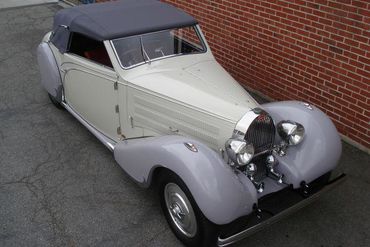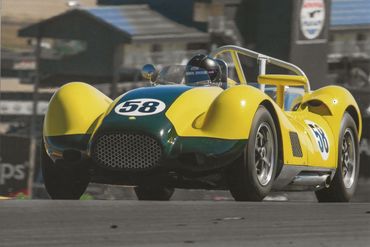Sold
SOLD 09/07
1939 Bugatti
T57 Stelvio Convertible
Classically Refined and Elegant Stelvio T57 Convertible
- VIN57740
- Exterior ColorLavender and White
- Interior ColorFaux Oxblood Aligator
- Mileage58063 Kilometers
- EngineDOHC 3,257cc Straight 8, Cyl
- Engine no.AD450
- Transmission4 Speed
- StatusSold
- StockFJ463
Description
1939 Bugatti T57 Stelvio Convertible s/n 57740 Lavender and White with Oxblood Alligator Grain Leather The Type 57 is one of the most celebrated of all non-racing Bugatti chassis. Its unbeatable combination of style and performance made it an instant success and, from its first introduction, provided Jean Bugatti with a final and lasting legacy for the automotive record books. Prior to 1934, Bugatti set the lofty goal of creating an automobile that exuded the excitement and racing heritage of the company, while incorporating the refinement and drivability of a road car. The Type 57 was successful in combining some of the character of the racing chassis, but offering a level of comfort that even the most polished of European elite appreciated. Some of the most memorable automotive designs undoubtedly carry the Bugatti name. Many of these were the inspiration of Jean Bugatti, and offered by him as factory catalog body styles. A number of Type 57 convertible bodies in his catalog were dignified and pleasing to look at, but lacked the flair seen on his racy closed cars, such as the Atalante or Atlantic. As a result, Bugatti envisioned a more exotic open car that would set a new standard for styling. The coach building firm of Gangloff was entrusted with the task of crafting the new model; the results were nothing less than spectacular. From early 1934 until the outbreak of the war in September 1939, the automotive output from Bugatti`s Molsheim factory was almost exclusively devoted to the Type 57 model and its later variants. While retaining several traditional Bugatti features this new model was, in many respects, a complete break with all that had gone before. Its engine capacity of 3.3 liters was substantially larger, physically and therefore inevitably somewhat heavier than its predecessors; however, its more efficient twin-camshaft engine producing 135hp provided a correspondingly higher specific output so that its road performance was not impaired. From the outset it was never regarded as an outright sports model but rather as a high-performance sporting tourer, which was nevertheless capable of carrying luxurious and commodious coachwork. By this time Ettore Bugatti himself was devoting the bulk of his time to the production of the Bugatti race cars while his son Jean played a leading role in the design and development of the new model. The 3.3-liter engine was completely new, with a five-bearing crankshaft at the back of which a train of helical gears drove the twin overhead camshafts. Although it retained fixed heads, the cylinder block was a single symmetrical casting providing classic hemispherical combustion chambers. Instead of the inverted bucket tappets of the earlier Miller-influenced Type 50, the new engine featured valve actuation by fingers interposed directly between the cams and their respective valves. The gearbox was also a completely new design with constant-mesh dog-engagement for second, third and top gear. And instead of being a separate unit as it formerly was, the transmission was mounted directly to the engine by a conventional bell-housing containing a normal single-plate clutch instead of the previous Bugatti multi-plate unit. Before 1927, the Bugatti factory had not produced coachwork for their own cars, if one discounts the racing bodywork of the Type 35, its variants and other early racing models. But thereafter they developed an increasing in-house capacity to produce their own traditional timber-framed coachwork, initially for the Grand Sport versions of the Types 40 and 43. From around 1930 onward, Jean Bugatti was to play an increasingly important role as a stylist, working in conjunction with chief coachwork designer Joseph Walter. For the new Type 57 model the factory offered a choice of the Galibier four-door saloon, the Ventoux two-door coupe and the Stelvio cabriolet, although the latter was, in fact, built by local coachbuilders Gangloff of Colmar. Alternatively, the cars could still be supplied in completed rolling chassis form so that their agents or clients could select their own coachbuilder to execute the construction to their own personal requirements. The Register and Data of Bugatti Automobiles, written by H.G. Conway in 1963, provides the earliest documentation of the 1939 Bugatti Type 57 Stelvio presented here. It states that the owner at that time was a Mr. John F. Comey. The registry identifies the T57 Stelvio as having a Gangloff drophead body finished in black and that it was first registered in 1939. In the 2003 edition of the American Bugatti Registry, compiled by highly respected Bugatti historian and Bugatti Club Registrar Sandy Leith, this car is listed as chassis number 57740, fitted with engine number 349. Although at some point the original engine and chassis stampings have been modified, Sandy Leith confirms this car to be chassis no. 57740. The Registry goes on to say that the car was originally delivered in 1939 fitted with engine number 515 (515 is the number still visible on the rear axle and the gearbox). The Bugatti would stay in the possession of Mr. Comey for nearly 50 years during which time it was treated to a long-term restoration. The vendor purchased the T57 at auction in 2005 and immediately began a complete concours quality restoration. Upon completion of the restoration, the car was titled as chassis no. 57450, returning to the number originally identified in the 1963 Bugatti Registry. However, there is no question that this is in fact the car identified as no. 57740 by the 2003 edition of the American Bugatti Registry. A right hand drive example, the T57 is finished in a stunning lavender and white color combination. Immediately after completing its restoration the Bugatti was shown at the Ironstone Concours dElegance in Murphys, California, where it was awarded the Foundation award. This trophy is given to the car with the most elegant detail, craftsmanship and beauty. Still with essentially zero miles since completing its restoration, the Stelvio is jewel-like in its appearance, and truly impressive to behold. The engine bay, trunk, and underside are all marvelously detailed and like-new. The Bugatti has a striking red leather interior with a wood dash and a beautiful wood steering wheel. The craftsmanship of the upholstery and installation are second to none. The exterior features a lavender cloth top, a matched set of Marchal headlights and the elegant six-barrel stainless exhaust tip. The engine bay and underside are both impeccably restored and detailed `to eat off of`. Overall, this lovely Type 57 is a wonderful representative of the classically refined and elegant Bugattis of the 1930s. The quality of the restoration, both cosmetically and mechanically, is absolutely fantastic. Because the original factory stampings on this car have been altered throughout its existence, it is very difficult to identify with any certainty the originality of the T57. However, one thing is certain, and that is T57 Stelvio Bugattis are versatile cars that are regularly featured at concours and shows worldwide. Additionally, there is a large and enthusiastic worldwide club that operates yearly with a variety of specialized events and tours for which this Type 57 would indeed be highly suitable. Much information courtesy of www.rmauctions.com.The above vehicle information is complete and accurate to the best of our knowledge at the time it is posted to this website. Corrections or additional information is always appreciated. All advertised prices exclude government fees and taxes, any finance charges, any dealer document preparation charge, and any emission testing charge. Vehicles are subject to prior sale. All advertised to be true but not guaranteed. We assume no liability for errors or omissions.
Inquire About This Car
Fantasy Junction • 510-653-7555 • 1145 Park Ave, Emeryville, CA 94608





